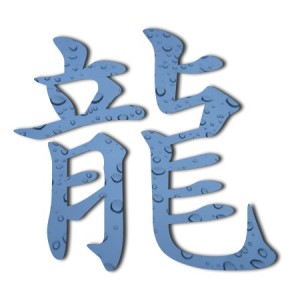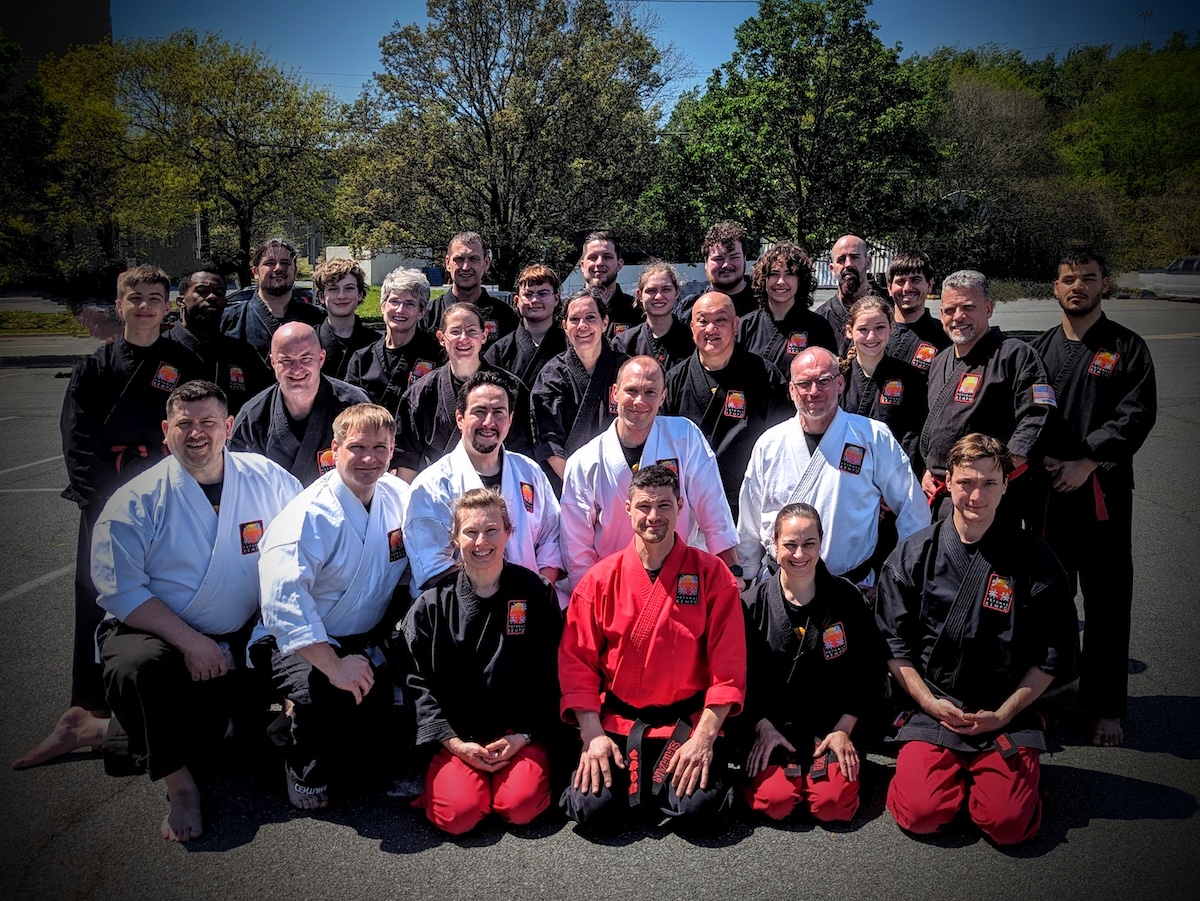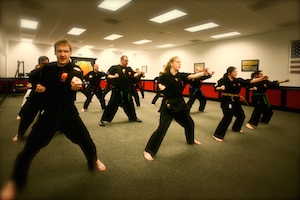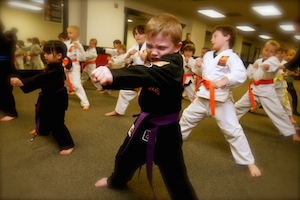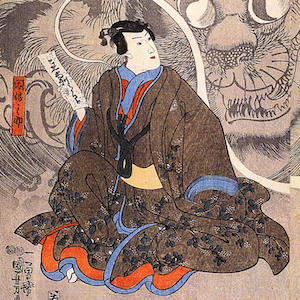In the West, Dragons have long been depicted as evil creatures that raid villages, hoard treasure and commonly end up being killed by valorous knights. Despite the use of the same name, Chinese Dragons could not be more contrastive. They differ substantially in appearance but more to the point they are almost universally benevolent. Dragons were first depicted in statues and carved into jade more than six thousand years ago. Since that time they have come to play an important role in Chinese culture and — to our point — the martial arts. This verse from a popular song by Hou Dejian illustrates how intertwined the Dragon is with Chinese culture
In the Ancient East there is a Dragon
Her name is China
In the Ancient East there is a people
They are all the heirs of the Dragon
The Dragon is interesting in that it is the only one of the five Shaolin animals which is mythological. Shifu Jason Parks describes the Dragon in this way: “The Dragon is a creature of the Chinese psyche, a creature of perception and imagination. For this reason the Dragon represents the spiritual world and its affect upon the physical.”
In a sense, her mythological origins are the basis for her mystery and her power. This image of the Dragon is best described by Kakuzo Okakura in his book, The Awakening of Japan
He is the spirit of change, therefore of life itself. We associate him with the supreme power or that sovereign cause which pervades everything, taking new forms according to its surroundings, yet never seen in a final shape. The dragon is the great mystery itself. Hidden in the caverns of inaccessible mountains, or coiled in the unfathomed depth of the sea, he awaits the time when he slowly rouses himself into activity. He unfolds himself in the storm clouds; he washes his mane in the blackness of the seething whirlpools. His claws are in the fork of the lightning, his scales begin to glisten in the bark of rain-swept pine-trees. His voice is heard in the hurricane which, scattering the withered leaves of the forest, quickens a new spring. The dragon reveals himself only to vanish. He is a glorious symbolic image of that elasticity of organism which shakes off the inert mass of exhausted matter. Coiling again and again on his strength, he sheds his crusted skin amid the battle of elements, and for an instant stands half revealed by the brilliant shimmer of his scales.
Mythological Origins
There are two plausible origins for the myth of the Dragon. The first is mundane: saltwater crocodiles, the largest of all living reptiles, lived in parts of China. The monsters, which can grow to thirty feet in length and over 4000 pounds may have inspired the myth of the Dragon, growing and evolving with each generation. The other, perhaps more enchanting theory, involves Huangdi, the first legendary Emperor of China. Huangdi used the Snake as his coat of arms and as he conquered other peoples he — according to legend — incorporated their totems into his own, creating, over time, the Dragon we know today.
In this context it is then fitting to see how the martial arts characterizes the Dragon as being an amalgamation of the other fighting animals. What is interesting is how this interplay results in the Dragon having characteristics that can’t be traced to an individual animal. As we will see, their combination gives them a life of their own.
Martial Origins
As one would expect by both her mythological origins and her martial usage, the Dragon has many of the characteristics of other animals. From the Crane, the Dragon draws her grace and patience; the Dragon and Crane are also the only two animals who favor evasion as a fighting tactic. Like the Snake the Dragon is flexible and fluid; they also both favor twisting movements and stances. The Snake will tend to entwine its opponent or use whip-like strikes to vital points, while the Dragon will instead tend towards powerful strikes to the face or body. The Dragon has claws like the Tiger and is strong like the Tiger, but has nothing else in common with him. In fact, their fighting styles are almost diametrically opposed. The Dragon is quick like the Leopard but uses her speed very differently, favoring twisting movements to the Leopard’s lateral movements.
So even as the Dragon draws her essence from the other animals she ends up being very different from each of them. For each similarity she shares with one of the animals she draws even more differentiating characteristics from the others. As a result, she is very much her own creature.
Striking and Blocking
The Dragon will on occasion use any strike, but she favors a closed fist and, not surprisingly, a Dragon Claw. A Dragon Claw is similar to a Tiger-claw but more open; it strikes with the palm and follows through with the fingers. It does not close like the Tiger-claw. She also, more than any other animal, strikes with a double punch, dropping her weight and with elbows in tight. Lastly, she uses a Dragon-Tail Kick, commonly known as a spinning hook kick. This can be deployed to the head, or to the legs as an Iron-Broom Sweep.
When blocking, the Dragon favors soft blocks, deflecting her opponent’s energy as little as possible. These are most often parries and pressing palm blocks. At a more advanced level she will incorporate a Dragon Trap, which begins with a pressing palm block to avoid being struck and then traps. In all of these cases the Dragon will twist her body while blocking. In some cases this will simply be a twist of the upper body, but it may be a full body twist, resulting in a twisted stance.
No Contention
The Dragon is a strictly defensive animal, never choosing to bring the battle to her opponent. Interestingly, the result of this characteristic is that no two Dragons will ever fight. They will both choose to Ride the Wind and will never confront each other head-on. As we learned from Master Kan in the television series, Kung Fu, “Where there is no contention, there is neither defeat nor victory.”
It is in this way that the Dragon defeats the Tiger. The Tiger is prone to attacking linearly and with great force. This approach leaves the Tiger very vulnerable to the Dragon’s typical defense of waiting for her opponent to commit himself and then using his energy against him. In fact, the stronger and more committed the Tiger’s attack, the easier it is for the Dragon to use his force against him. On the opposite end of the spectrum, the Leopard defeats the Dragon because it does not commit its energy like the Tiger does, but instead maintains very even stances and moves laterally. The Leopard never gives the Dragon an opening to exploit and wears her down with quick, short strikes.
Fighting Style
As is necessary with all twisted stances, the Dragon will drop into these blocks, lowering her weight and strengthening her base. A common tactic is to have one hand deflecting a strike as the opposite hand strikes forward. Alternately, the Dragon will coil into her block and unwind into her counter, often rising at this point. This twisting while rising and falling creates a very fluid fighting style. Furthermore, the pulling and drawing results in a very close-range fighting style. Grandmaster Steve DeMasco makes the point that this requires relaxed and fluid muscles that can quickly transition from soft to hard movements.
The Dragon moves as little as possible, waiting for her attacker to close the distance first. As Sijo Trevor Haines writes, the Dragon “positions her body in the empty space, and fills the void left by the impatient.” In this way she can unbalance her attacker and deflect attacks before they reach full power and extension. She will move from the tense side of her opponent’s attention, to the lax side of his inattentiveness, often striking from behind to an unexpected area.
It is in this last concept that we see the connection with the Dragon’s mythological origins. As mentioned earlier, the Dragon represents the spiritual world’s affect on this world and is never seen “in a final shape.” The pinnacle of a Dragon technique is one where moments after intercepting an incoming attack the Dragon has managed to position herself directly behind her attacker, effectively disappearing.
Physical Benefits
We, as practitioners, derive some very specific benefits from applying the techniques of the Dragon. These result from dedicated training and striving to make the Dragon’s strengths our own.
Waiting for an attacker to close the distance, rather than charging forward like the Tiger, requires — and develops — patience. Likewise, executing a deflection at exactly the right moment will develop our timing. To make a deflection optimally effective requires that we feel the attack and displace it as little as possible; practicing this will improve our sensitivity. Twisting repeatedly into low stances will improve our fluidity. It will also strengthen our legs and core, while opening our hips and making us more flexible.
Mental Characteristics — Shen
In Chinese culture, Traditional Chinese Medicine, QiGong and elsewhere, Three Treasures are described. These are the Jing, the Qi and the Shen, and they represent the essential energies sustaining human life. Each term is very broad but we can think of them in simple terms as the Body, the Spirit, and the Mind respectively. This is an over-simplification but it serves our purposes here.
The Dragon manifests the fully-developed mind — the Shen. The Dragon views things in an enlightened way and is not constrained by details and conventional thinking. As such, the Dragon is our source for developing wisdom and discipline.
Every day, people take a store of knowledge and apply their intellect to it in the hope of solving problems. Sometimes they succeed and sometimes they don’t. Intellect and knowledge are insufficient without wisdom. It is wisdom that asks if the problem has a solution and if it worth solving. It is wisdom that filters the results of an intellect churning through data.
The Dragon, too, helps us to develop discipline, which we define as total control over our own actions, thoughts, and emotions. Only when we take full responsibility for ourselves, both in what we do and how we feel, can we expect to have real ownership of our lives and our futures. We must first master ourselves before we can hope to master the world around us, and the Dragon helps us to do both.
Riding the Wind
One of the most common themes in discussing the Shaolin Dragon is her ability and tendency to “Ride the Wind.” This trait is addressed by martial artists of many lineages and is, in some ways, the core of the Dragon’s nature. The concept is described quite simply in this excerpt from a children’s book, “No matter what comes at you, you can be flexible like the Dragon. Just go with it. That way nothing can defeat you.” Even more simply this philosophy can be articulated as observing what life has in store and responding by saying, “That’s okay.”
We see this characteristic manifest in the Dragon’s fighting style described earlier. O Sensei Morihei Ueshiba, the founder of Aikido, put it this way, “Nobody can take away my strength, because I do not use it.” In this way the Dragon is seen to follow rather than lead. She allows her opponent to bring to bear whatever energies he wishes, and then simply rides with them until they are over extended — and then she responds.
This concept is much broader than physical confrontations; learning to “Ride the Wind” in common daily situations can greatly improve our lives. There are many circumstances that we encounter every day where the course of events seem to be at odds with our expectations and plans. It is common for us to fight against these events, as the Tiger might, to force them to go our way. This is often unsuccessful and, even when successful, often much more fatiguing than necessary.
Here the Dragon would counsel us to adapt to the situation rather than trying to make it adapt to us. We could then wait for an opportune time to correct or exploit the turn of events. There are environments, of course, where riding the wind is not appropriate, such as any time when even a slight deviation from your intended course of action would be disastrous. These circumstances might include those where integrity is at stake or one’s well being is on the line. In these cases the Dragon’s method might not be appropriate and we should seek counsel from another one of the animals.
The two questions to ask when determining if one should Ride the Wind in a particular situation are as follows: “Are the consequences catastrophic?” and, “Can I control this?” If the answers are both “No” it might be best to Ride the Wind rather than screaming against it. Trying to fight against these things will rarely improve the situation and will only make us angry and frustrated. It is better to heed the Dragon’s advice and Ride the Wind, following the new course of events wherever they lead.
In Summary
The Dragon is a glorious creature of myth and legend. But she is also a compelling guide to martial techniques and successful living. She teaches us to deflect and absorb while staying relaxed and calm. She encourages thoughtful consideration and focused discipline. Perhaps most importantly, she teaches us to be fluid like water and to Ride the Wind.
